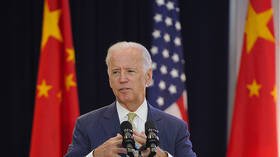Dems’ 2020 campaign mirrors 2016: They ran against Trump & Putin then, they’re running against Trump & Covid now
The 2020 US presidential race is following the trajectory of the 2016 race. The Democratic agenda is the same: an attack on the character and competence of Donald Trump and a promise to restore the status quo ante.
The Democratic Party has once again nominated for president someone who not only lacks ideas, energy and charisma but who also doesn’t appear to do much in the way of campaigning.
In 2016, the Democrats ran against Trump and Putin; today they are running against Trump and Covid. Nonetheless the Democrats are leading comfortably in the polls and are predicted to be cruising to a comfortable victory.
Meanwhile, Trump, the shock winner of 2016, is scrambling desperately, rushing from state to state, holding three, sometimes four, rallies a day, but appears to be heading for a defeat of landslide proportions. As in 2016, there was an October surprise: a massive document dump, which much of the media are going out of their way to ignore, given that its contents reflect poorly on their favored Democratic candidate.
As in 2016, most of the political commentary on this race consists of analyses and predictions based on the polls: since the polls show a big lead for Joe Biden, it stands to reason he must be heading for a big victory. Such faith in the incontrovertibility of the polls is extraordinary. In vote after vote in recent years, the polls have proved to be spectacularly wrong. They were wrong in the presidential election of 2016; the Brexit referendum of 2016; the UK elections of 2010, 2015 and 2017; the Israeli election of 2015; and the Australian election of 2019. It is clear that pollsters are failing to address serious issues of bias and flawed methodology. Above all, pollsters continue to fail to address the consequences of a refusal on the part of most potential voters to respond to pollsters’ phone calls.
In their obsession with polls, the media invariably fail to consider other important election outcome determinants such as voter enthusiasm and voter registration drives. In 2020, the Republicans appear to have a decisive edge on both. What matters is not voters’ preferences, but whether they are prepared to stand in line (often in the cold) for hours on end to cast their ballot. Trump supporters are excited about their candidate, Biden supporters are not.
In 2012, polls showed a likely win for Mitt Romney. In the end Barack Obama won comfortably. Republican voters, unenthused by Romney, failed to show up. On the other hand, African-American voters showed up in unprecedented numbers for Obama. In 2016, this was reversed. African-American voters who had voted eagerly for Obama in 2008 and 2012, failed to show up for Hillary Clinton.
What voters tell pollsters about their voting intention often bears little relation to what they do on Election Day. When a political party selects as its standard bearer someone seen to be safe and electable, rather than someone with a bold, distinctive agenda to inspire the party’s base, voters stay home—and the nominee, with the impressive resume, gets trounced. This happened in 1984, when the supposedly electable Democratic Party nominee Walter Mondale was crushed in a 49-state landslide by Ronald Reagan. It happened again in 1996 when incumbent Bill Clinton hammered electable GOP nominee Bob Dole, and again in 2004 when unpopular, incompetent incumbent George W. Bush managed to eke out a win against uninspiring but electable Democrat John Kerry. And, of course, Obama defeated electable Romney in 2012.
In 2016, also, Hillary Clinton’s selling-point was that she was far more electable than her rival Bernie Sanders. In the end, Sanders would probably have fared better in the general election.
Biden is the consummate Washington insider. He served as senator for Delaware from 1973 to 2009, then as vice president from 2009 to 2017. Throughout his time, he has dutifully done the bidding of the credit card industry, much of which is registered in Delaware. He is also, notoriously, sponsor of the Violent Crime Control and Law Enforcement Act, also known as the 1994 Crime Bill. When it comes to foreign policy, Biden has never seen a US military intervention he didn’t like. The one exception was the first Gulf War in 1990-1991. However, his opposition was less a matter of principle and more a matter of keeping in with Senate Democrat leaders who opposed the war.
Also on rt.com Kamala Harris’ final push to voters through ‘equality v equity’ video slammed as ‘woke Marxism’Biden’s record is thus not one to inspire younger, more radical, idealistic voters to rush to the polls in numbers sufficient to overcome Trump’s numbers. To be sure, there is the anti-Trump factor. The desire to defeat Donald Trump is indeed intense. However, that was true in 2016 as well. Trump was repeatedly assailed as racist, sexist, misogynist, Fascist, and as a Russian stooge into the bargain. This time, unlike in 2016, though, Trump doesn’t need to worry about opposition within his own party.
In 2016, the Never Trumpers within the Republican Party were a far more significant force then than they are today. Many, though certainly far from all, Never Trumpers now support the president. The rest—the Bill Kristol crowd—have gone over to the Democrats. Historically, incumbents who enjoy overwhelming support within their own party are re-elected. It is when an incumbent is challenged within his own party that he fails to win re-election: Democrats in 1952, 1968 and 1980; Republicans in 1992.
While Trump has certainly lost support among college-educated white voters, he has compensated for that loss by winning over African-American and Hispanic voters. Nonetheless, Trump’s message is very different from the one he ran on in 2016. Back then, he sounded like a genuine populist. He attacked corporations for offshoring, outsourcing and hiring non-Americans. He promised to penalize corporations that closed down factories in the US and moved jobs overseas. He seemed open to universal health care coverage.
Today Trump warns that Biden would bring “socialism” to America even though his less-than-affluent, non-college-educated supporters would look favorably on major new government-spending programs. Today, Trump touts the soaring stock market and 401(k)s, even though the people he’s addressing don’t have the resources to invest in stocks. Trump talks little about American workers getting replaced by imported or illegally-arrived labor from abroad. The anti-interventionist rhetoric of 2016 has been supplanted by boasts of having walked away from the Joint Comprehensive Plan of Action with Iran, of occupying Syria in order to seize its oil, of providing arms to Ukraine, of being “tougher with Russia” than any other president.
As a result, Trump, who should be cruising to a comfortable victory, is fighting for his political life against one of the weakest party nominees of the recent era. The election could well be decided in the courts as parties fight over which votes should be counted and which discounted.
For the rest of the world, foreign policy in a Trump second term will probably be very much as it was in the first term. There will be no withdrawal from Syria or Iraq; the maximum pressure campaign against Iran will probably intensify; there will be new sanctions against Venezuela; and the New START Treaty with Russia will be allowed to lapse.
Biden, on the other hand, is like Clinton in 2016, explicitly promising to pursue a foreign policy more hawkish than Trump’s. With Biden comes Jake Sullivan, who served in the Hillary Clinton State Department and now sits side-by-side with Bill Kristol on the Advisory Council of the Alliance for Securing Democracy, an organization devoted to scaremongering about “Russian interference” in everything. With Biden comes former Obama Deputy Secretary of State Anthony Blinken who has promised to re-start the regime-change war against Syria.
With Biden comes Nicholas Burns, former US ambassador to NATO, alumnus of the Clinton and Bush administrations, eager participant in NATO’s 1999 bombing of Yugoslavia, enthusiastic interventionist and a Russia hawk. And with Biden of course come the two architects of the Libya catastrophe: Samantha Power and Susan Rice.
Given the likelihood that a Biden administration will pursue a foreign policy more interventionist and more belligerent toward Russia than that of Trump, most of the rest of the world should be willing to see Trump win. It isn’t of course; it’s willing on Biden. No surprise: People rarely do what’s in their best interest.
Like this story? Share it with a friend!
The statements, views and opinions expressed in this column are solely those of the author and do not necessarily represent those of RT.















